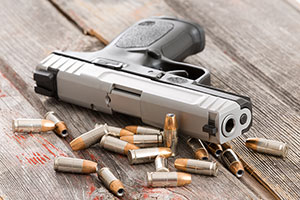The acquittal of Jose Ines Garcia Zarate, who was charged with murdering Kate Steinle, has made national headlines, in part because President Trump tweeted his dissatisfaction with the “disgraceful” outcome. The jurors, unlike the president, decided the case after considering the competing expert witnesses who advanced and undermined the prosecution’s theory of guilt.
The Murder Charges
Kate Steinle was shot while walking with her father on San Francisco pier. The bullet that struck her ricocheted after being fired into the concrete walkway. The question for the jury was whether Garcia Zarate caused the gun to fire accidentally or whether he deliberately or recklessly caused Steinle’s death.
Given that the bullet was fired into a concrete pier 12 feet from where Garcia Zarate was seated, then traveled about 78 feet before striking Steinle in the back after it ricocheted, it is difficult to understand how the prosecution believed it could prove that Garcia Zarate intended to kill Steinle. California law requires proof of a deliberate, premeditated, and intentional killing to support a first-degree murder conviction. Killers who target a specific victim for death don’t count on making a bank shot.
The more serious question was whether Garcia Zarate intended to shoot the gun on a crowded walkway. Second-degree murder under California law does not require proof of an intent to kill, but it does require proof of an intent to commit the act that caused the victim’s death. The prosecution must also prove that the defendant knew that the act was dangerous and consciously disregarded the risk to human life.
The third charge, involuntary manslaughter, required the prosecution to prove that Garcia Zarate engaged in reckless conduct that created a high risk of death or serious injury. Causing an accidental death by careless action that does not rise to the level of recklessness is not a crime under California law. The last charge, assault with a firearm, also required proof of a purposeful shooting.
Facts at Trial
Several key facts were undisputed. The gun had been stolen from the vehicle of a Bureau of Land Management ranger days earlier. The prosecutor did not claim, and no evidence suggests, that Garcia Zarate stole the gun.
Steinle was struck with a single bullet; she was not shot five times, as Donald Trump claimed during his presidential campaign. No evidence suggested that Garcia Zarate knew Steinle or that he had a motive to kill her or to harm anyone on the pier.
Other facts were less clear. Although the gun was clearly pointed at the ground when it discharged, prosecutors claimed Garcia Zarate deliberately pointed it at Steinle, or at least in her direction. The defense contended that Garcia Zarate found an object wrapped in a rag or T-shirt on the pier. Garcia Zarate said he didn’t know the object was a gun until it went off as he was unwrapping it.
The police interrogated Garcia Zarate for four hours after his arrest, and his statements contradicted each other as well as the physical evidence. At one point he said he was shooting at a sea animal. He also said the gun went off when he stepped on it.
Whether Garcia Zarate admitted to pulling the trigger, or merely admitted that he fired the gun, is also unclear. The accuracy of the police translation of the interrogator’s English-language questions into Spanish and of Garcia Zarate’s Spanish-language questions into English was disputed at trial.
John Evans’ Testimony
John Evans, a San Francisco Police Department crime scene investigator, testified as an expert witness for the prosecution. He asserted that “A human being held the firearm, pointed it in the direction of Ms. Steinle, pulled the trigger and fired the weapon, killing Ms. Steinle. This is the only way it could have happened.”
That kind of certainty, when coming from an expert witness who wasn’t at the scene and didn’t see what happened, will often backfire. Juries perceive expert witnesses as arrogant when they suggest that they have an exclusive window on the truth. When that expert is impeached, juries more readily discount the expert’s testimony as being result-oriented rather than objective.
Evans also testified that inexperienced shooters often jerk the trigger of a gun, causing it to fire before the barrel is pointed directly at the target. Evans theorized that the bullet was meant for Steinle but hit the concrete pier for that reason. He also testified that guns don’t fire accidentally.
Evans based his conclusion that Garcia Zarate pointed the gun at Steinle on a “vector” analysis, essentially using a laser pointer to show that the place where the gun was fired, the place where the bullet hit the pier, and the place where Steinle was standing all fell within straight line. Evans was allowed to give that testimony over a defense objection that it was based on “junk science.” Evans admitted on cross-examination that the CSI team could not determine where Garcia Zarate was when the gun was fired, and only knew approximately where Steinle was standing based on blood stains.
Evans also admitted that the bullet may have changed direction after it hit the pier. When asked how he could be certain that the bullet followed a straight path if it might have changed direction, Evans changed the direction of his testimony, explaining that bullets spin and tumble after they strike an object, but still travel in a direction that is “essentially straight.”
Finally, the defense asked Evans whether he knew that the shooting was an accident or not. “I cannot say” was his honest answer, and it established a reasonable doubt that probably helped the jury vote “not guilty.”
Evans’ Result-Oriented Testimony
Evans played a crucial role in the 2010 trial of Jamal Trulove, a former reality-show contestant who was convicted of murder. Although the placement of shell casings that had been ejected from the murder weapon cast doubt on eyewitness testimony that implicated Trulove, Evans claimed that casings fall “randomly” after they are ejected and can end up in front of the shooter’s position. That testimony, which Evans claimed to base on his own experience firing guns and on a report prepared by a police inspector, was later discredited by experts who explained that casings ejected from the kind of handgun used in the murder are always ejected to the right and backward.
Truelove’s conviction was reversed on appeal and he was acquitted after a second trial. In a post-conviction deposition, Evans admitted that he never read the report about patterns made by ejected casings that another police inspector prepared, even though he testified about that report at Truelove’s trial. Evans claimed to have discussed the report with its author, but the author denied any recollection of discussing it with Evans. The inspector also said that Evans’ trial testimony misrepresented the contents of his report.
The prosecution probably should have known better than to rely on Evans, given his performance in the Trulove trial. Before charging first-degree murder in a case where the lethal bullet ricocheted, it is surprising that the prosecution did not confirm Evans’ theories with independent experts.
Defense Experts
The defense countered Evans’ testimony with the expert opinion of James Norris, a former San Francisco criminalist and director of the Police Department’s forensics division. Norris testified that a ricocheting bullet can change direction, and that the bullet’s path after the ricochet is impossible to predict.
Norris also testified that the gun was probably “1½ to 2 feet off the ground” when it was fired, a position that would have been below Garcia Zarate’s knees. “In that position, it would be extremely difficult to aim,” Norris testified.
The defense also relied on the expert opinion of Alan Voth, a firearms forensic expert who spent 35 years with the Royal Canadian Mounted Police. Voth testified that accidental discharges of firearms are common.
After explaining why guns fire accidentally, Voth pointed to the evidence that Garcia Zarate did not intend to fire the gun. He emphasized that only one shot was fired, that the bullet struck the ground, and that Garcia Zarate had no motive to shoot a stranger.
Politics and the Verdict
There is no question that Garcia Zarate received a fair trial and that the jury deliberated carefully and based its verdict on the evidence, including the testimony of experts. While the president and others have suggested that the verdict should make people angry, there is no cause for anger when a jury follows the law and rejects speculative theories of guilt.
Politics has no role in the criminal justice process. Verdicts must be based on evidence, not political opinions. The Garcia Zarate trial demonstrates the valuable role that experts play in assuring that defendants receive a fair trial by helping juries evaluate the evidence that will determine their verdict.













